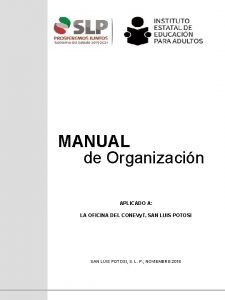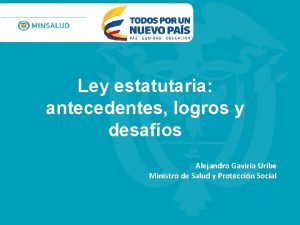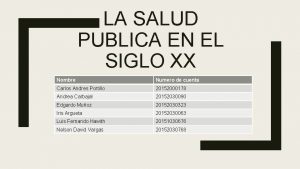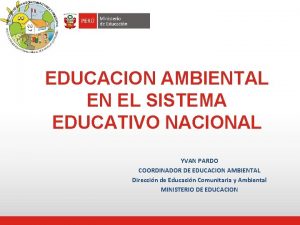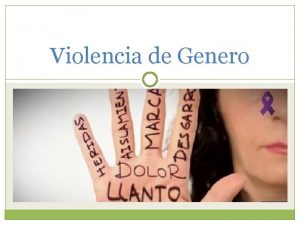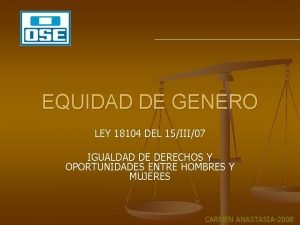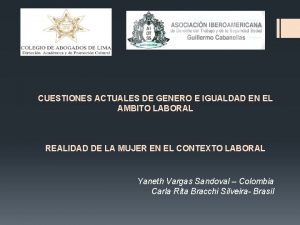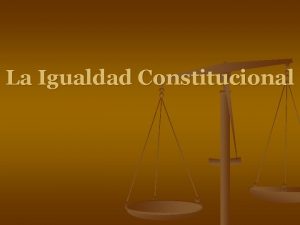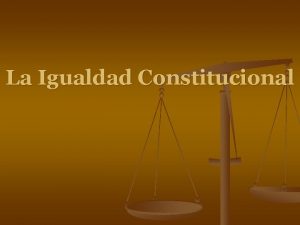Integrando Igualdad de Genero en la OPS Logros



















- Slides: 19

Integrando Igualdad de Genero en la OPS: Logros y oportunidades, Informe del 2009 – 2011 Mesa Directiva - Conferencia Regional sobre la Mujer Jueves 8 de noviembre, 2012 Santiago, Chile Cathy Cuellar Oficina Genero, Diversidad y Derechos Humanos (GDR)

Gender Inequalities persist… • Women live longer than men, with lower mortality throughout, though added years are not quality years – burden of disease? • 1/3 of women experience partner violence: discrimination and impunity continues. • Women/girls are principal care providers of children, elderly and disabled • Gender inequality is more explicit when illness/ death disproportionately affect poor women, ethnic groups or adolescents

2005 Policy approved by MS Resolution: Po. A, TAG, Monitoring 2012 Monitoring Report (Sanitary Conference)

Po. A Monitoring Process • GDR – coordinator • Developed monitoring tool; gathered information and prepared report in participatory process (36 countries) • Prepared GB document.

Monitoring Framework follows Strategic Objectives of GE Policy and Po. A Action 1: Evidence building Action 4: Monitoring and evaluation Gender Equality Policy Goal: Achievement of gender equality in health status and health development Action 3: Participatio n of civil society Action 2: Capacity Building

Action Area 1: Improving Evidence PASB 2005 - 2010 ü Health in the Americas (2012) ü Health situation of Women and Men in the Americas (2009) (with UN) ü Gender, Health and Development in the Americas: Basic Indicators, 2009

Action Area 1: Improving Evidence Publications (63), Guidelines (50), ¾ disaggregated by sex

PASB Evidence Publications Regional level Subregional level National level

Action Area 2 : Capacity-Building Staff and partner training - - PASB staff /partners from 20 Cs (2008/09): 30 PASB gender focal points Virtual course on Gender and Health: intersectoral teams from 5 Cs = 57 Mandatory e learning (WHO in process) BWP training/manual for all PAHO staff Knowledge platforms - Webpage, listserve, databases Annual Best Practice contest!

Action Area 2: Capacity-Building (cont) PASB STAFF PARITY

Action Area 2: Capacity-Building (cont) MEMBER STATES: • Most Cs have national gender equality or equal opportunity laws that apply to the health sector. • 17 Cs have specific health and gender policies • 8 have specific units • 14 Cs have budgets by law • Gender activities mostly donor supported. • 80% have no parity policies for staffing

Países con políticas/programas/planes de género y salud; y países que cuentan con presupuestos para género. Treinta y seis países de ALC Países de CA y República Dominicana

Action Area 3: Participation of Civil Society PASB • • • Consultation Po. A, monitoring Technical Advisory Group Training International events, UN panels Collaboration with Network of Women’s Health of LAC Countries • Half report CSO participation

Action Area 4: Monitoring and Evaluation • WHO evaluation • Review of PASB corporate documents • Monitoring of Po. A and reporting 2012 and 2014 • PMA

Obstacles to mainstreaming Gender in Health • Resistance to change => biomedical and patriarchal model of health. • Lack of political will • Limited coordination between health managers, stakeholders and/or sectors and donors • Lack of training and culture of gender analysis in health sector (inequalities invisible) • Constant rotation of trained health staff

CONCLUSIONS • Even with challenges, results show progress. • The greatest challenge to Gender Mainstreaming (GM) in health is political support. • More health information produced by PASB HQ could be disaggregated by sex, and even more should be analyzed with a gender perspective. • Countries report important levels of CSO participation, as partners in GMS. • Most support for GMS provided by donors and UN agencies. PAHO’s contribution varied and absent in some countries. • PAHO's strong commitment to mainstreaming gender and Director’s leadership is a model for the Region…

Country Recommendations • MOH should clearly position theintegration of gender in national health plans: § § specific gender policy and plan of action with indicators designated budget and trained staff (focal points at all levels) coordinating units monitoring systems • The Gender Policy should include other components related to gender equality and health: masculinity/male involvement, unpaid health care, equal compensation of health workers and sexual harassment policies.

What next…

Gender Equality is Good for Health! www. paho. org/gdr
 Calor especifico a presion constante
Calor especifico a presion constante Objective distribution
Objective distribution Logros del tecnico docente conevyt
Logros del tecnico docente conevyt Descubrimiento de galileo galilei
Descubrimiento de galileo galilei Hoja de vida atractiva
Hoja de vida atractiva Logros de alejandro gaviria
Logros de alejandro gaviria Canada sistema de salud
Canada sistema de salud Que cosa bonitas tengo para dar
Que cosa bonitas tengo para dar De que me debo desprenderme
De que me debo desprenderme Matriz de logros ambientales
Matriz de logros ambientales Hola pictograma
Hola pictograma Competencias especificas
Competencias especificas Hacer tareas
Hacer tareas Verbos para objetivos procedimentales
Verbos para objetivos procedimentales Logros de animales
Logros de animales Logros de aprendizaje ejemplos
Logros de aprendizaje ejemplos Gndu verification
Gndu verification Field scout mobile app
Field scout mobile app Ad monsters
Ad monsters Pans ops vs terps
Pans ops vs terps


